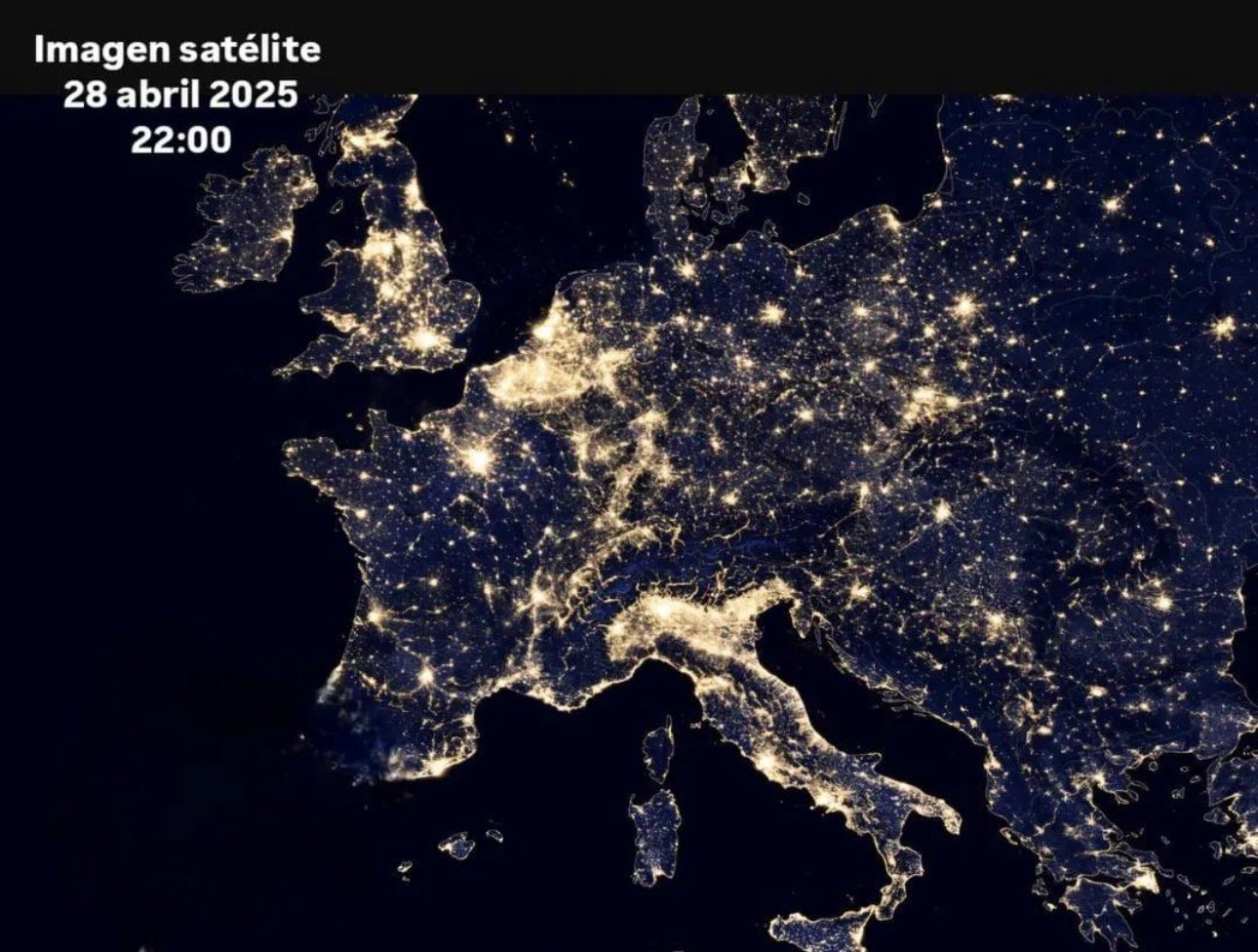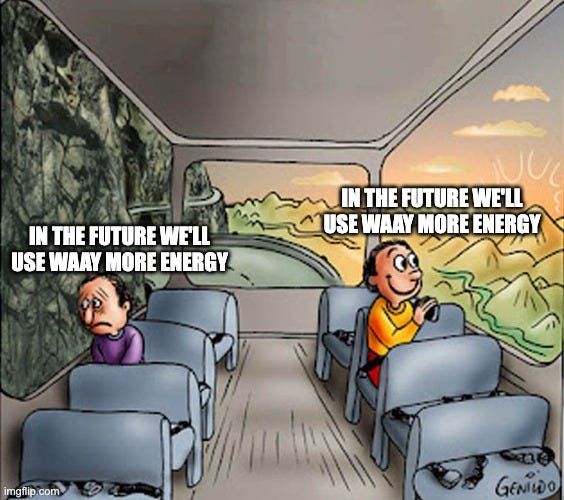Accelerate #2: Possibly Preventable Power Problem in Portugal
Beyond Ideology: Why Physics Matters More Than Politics for Power Grids
It’s always darkest before … it goes pitch black.
On April 28, 2025, the lights went out across Spain and Portugal. Not a flicker, but a near-total collapse, plunging me and ~55 million of my Iberian friends into darkness and chaos. Trains stopped, traffic lights died, hospitals scrambled onto backup power, mobile networks went silent, and the internet became unavailable. It was one of the most severe blackouts in recent European history.1
Aside from a small number of (very brief) power-cuts in the UK, this was a totally new experience for me and a fantastic reminder of how reliant we have become on electrical and communication networks in general.
The electrical grid is one of the most complex structures built by mankind; the more you learn about grid engineering, the more miraculous it becomes. The fact that when you flip a switch, you can expect, with high confidence, that you’ll receive magic electrical power has amazed me ever since I learnt about it as part of my Engineering degree.
So, what better time than a multi-national scale outage to dust off a few mental cobwebs and work out what the hell just happened?
Although no one has all the answers right now, what we do know reveals a story not just about a single failure, but about the inherent fragility of our modern power grids as we race towards a renewable future without properly addressing the engineering realities in front of us.
The Collapse: A Five-Second Catastrophe
Just after midday, Spain’s grid operator, Red Eléctrica (REE), detected an event (we’ll call it N-1) - likely a loss of generation. The system momentarily stabilised. Then, 1.5 seconds later, a second event (N-2) hit. The instability escalated. Within another 3.5 seconds - a mere five seconds from the initial trigger - the crucial power line connecting Spain to France automatically tripped, isolating the Iberian Peninsula to protect the rest of Europe.
Cut off and destabilised, the Iberian grid haemorrhaged power. In those same five seconds, 15 gigawatts of generation tripped in Spain (60% of its demand at that instant), along with 5 gigawatts in Portugal. The grid frequency, the vital heartbeat of the system, plummeted. Protective systems across the peninsula fired, generators tripped offline, and the entire network cascaded down into collapse.
What’s interesting here is the occurrence of two generation loss events (N-1 and N-2) at the same time; generator losses are widely considered to be uncorrelated, independent events, and to see two should be extremely rare! In fact, situations like this are so rare that grid operators generally only consider the possibility of a single generator event when designing contingency plans.
Details on the specifics of these events have, disappointingly, not been provided yet.
Grid 101: The Never-Ending Balancing Act
To understand what happened, a quick Grid 101. As I said earlier, power grids are extremely complex machines demanding constant, perfect balance. Generation must instantaneously match consumption (demand). Too much generation, and the grid’s frequency (normally a rock-steady 50 Hertz in Europe ) rises. Too little, and it falls. Voltage, the electrical "pressure," must also stay within tight limits. Deviations risk damaging everything from your fridge and home appliances to the grid infrastructure itself.
Inertia: The Grid’s Unsung Hero
But there’s another crucial factor: inertia. Think of it as the grid’s physical shock absorber. Traditionally, this inertia comes from the massive, spinning turbines and generators in conventional power plants (coal, gas, nuclear, hydro). These heavy rotating masses store kinetic energy. When a disturbance hits and frequency starts to change, this stored energy is automatically released (if frequency drops) or absorbed (if frequency rises), resisting the change.
Crucially, inertia slows down how fast the frequency changes (the Rate of Change of Frequency, or RoCoF). This buys precious seconds for slower control systems to react and stabilise the grid. High inertia means stability; low inertia means fragility.
The Renewable Conundrum & The Trigger Debate
Here’s where it gets complicated (and a bit political). Solar panels and most modern wind turbines connect via inverters. They don’t have those large, spinning physical masses. So, as we replace conventional plants with these inverter-based resources (IBRs), the grid’s natural inertia decreases.
On April 28th, renewables hit nearly 80% of Iberian generation, with solar alone near 60%. This meant the system was operating in a critically low inertia state.
This specific point has been seized by the anti-renewables contingent as a means of dismissing solar and wind as a problematic, impractical source of energy, with the implication being that we should use common sense and go back to good ol’ synchronous generation (Gas, Coal, Nuclear), etc.
On the other hand, the more ideological supporters of renewable energy have been quick to dismiss these claims as biased junk science.
So, was low inertia the cause? Well, right now it’s unclear. Experts are divided. Many point to the initial N-2 contingency - two generators tripping almost simultaneously within 1.5 seconds - as the real, highly unusual trigger. No system, they contend, is designed to withstand such an extreme event, especially when isolated from European support.
However, it’s delusional to downplay the possibility that low inertia played a critical role in the consequences. Once the N-2 event happened and Iberia was islanded, the frequency likely dropped so fast (high RoCoF) in the low-inertia environment that protective relays on a massive 15 GW of other generation tripped almost instantly. These relays are designed to protect equipment from damagingly fast frequency changes.2
So, while low inertia might not have caused the initial N-2 trigger, it almost certainly made the system vulnerable to a rapid, total collapse following that trigger. The grid lacked the resilience to cushion the blow, and highlighting this doesn’t make someone “anti-renewable.”3
Ignoring the Alarm Bells
This fragility wasn’t a secret. The warnings were clear and numerous:
ENTSO-E (Europe’s TSO Network) repeatedly warned that declining inertia increased the risk of system splits and blackouts.4
REE/Redeia (Spain’s Operator/Parent Co.) flagged the need for more storage and interconnections back in 2020. As recently as February 2025, Redeia warned investors of "generation disconnections due to the high penetration of renewables" and reduced inertia.5
CNMC (Spain’s Regulator) reported in Jan 2025 that grid voltage levels were already hitting dangerous thresholds.6
Experts warned about phasing out inertia-providing plants too quickly and the "unplanned and haphazard integration" of renewables without adequate grid upgrades.
The risks were documented. The question is why they weren’t adequately addressed before the system reached breaking point.
Politics, Spin, and the Price of Stability
In the blackout’s aftermath, the predictable blame game erupted. Government officials and REE’s leadership publicly denied that renewables were the issue, sometimes contradicting earlier internal warnings. Opposition parties accused the government of prioritizing green policies over grid security.
Was it a cover-up? Maybe not active concealment, but the inconsistencies suggest significant “narrative management”. Acknowledging that the pace and manner of the energy transition, without sufficient parallel investment in grid stability, created the conditions for collapse is politically difficult. It forces uncomfortable questions about who pays for grid upgrades and stability services, costs often postponed or passed to consumers.
It's Not Hopeless: Modern Solutions Exist
The inertia problem doesn’t mean we ditch renewables. It means we need to engineer solutions alongside them. Fortunately, the toolkit exists:
Synchronous Condensers (SCs): These are essentially large rotating machines run without fuel, specifically designed to add physical inertia and voltage stability back into the grid. Think of them as spinning stabilisers. Deployment is already happening, including by REE on Spanish islands.
Fast Frequency Response (FFR) & Synthetic Inertia: Using smart power electronics, IBRs (like solar, wind, and batteries) can be programmed to rapidly inject or absorb power in response to frequency deviations, mimicking inertia’s effect.
Grid-Forming Inverters (GFIs): The next generation of inverters. Instead of just following the grid’s lead, they can actively form it, establishing their own stable voltage and frequency, much like traditional generators. Crucial for very high renewable grids, but large-scale deployment is still emerging and untested.
Energy Storage (Batteries & Pumped Hydro): Essential partners. Batteries provide the ultra-fast response needed for FFR and synthetic inertia. Pumped hydro offers large-scale storage and traditional inertia. Often scoffed at by renewables sceptics as impractical, decades of work on battery tech has made this more feasible.
The point is: we can build stable, high-renewable grids. But it requires deliberate investment in these solutions, not just assuming the grid will cope. It also requires we move past some of the unhelpful ideologies and childish hysteria surrounding topics like Climate Change.
As much as a successful renewable energy future is something everyone should be able to get behind, fossil fuels and nuclear are not the devil. Of course, carbon emissions and pollution are a major problem that we must continue to address, but let’s not forget that those very same molecules are responsible for lifting more people out of poverty than virtually anything else in history.
The ridiculous idea that energy use is a bad thing has warped so many minds that we’ve strayed into some very strange places psychologically (remember those articles telling us that the best thing to do to reduce carbon emissions was to avoid having kids … I mean, seriously, do people fall for this stuff?).7
It’s fine to toss around a few dumb ideas in WhatsApp, but when it comes to designing the power grid, let’s try to be a bit less silly, please.
Bright Side
To round out this fairly concerning piece, I wanted to add something a bit more upbeat.
After a few hours of power loss and especially once the internet was lost, I noticed a real change in the behaviour or people out on the streets - without access to a super-stimulatory device in their pocket, people were chatting (to strangers) more and engaging in more “wholesome” activities - groups in the park, reading books on the balcony etc.
Drivers were also being quite considerate of pedestrians, and there was a general feeling of community and people uniting around a shared problem.
It was a nice (though brief) reminder that switching off is good for us sometimes (and that I need to make sure I always have access to an FM Radio, powerpacks, and firelighters!)
Summary
The Iberian blackout is a powerful reminder (pun intended). Renewables are fantastic, but they aren’t plug-and-play replacements for the inherent stability that conventional plants have provided for decades. The transition demands massive, proactive investment in grid modernization, storage, and specific stability technologies.
Ignoring the physics, downplaying risks, and underinvesting in resilience is, as one analyst warned, like “playing Russian roulette with the grid”. On April 28th, the chamber wasn’t empty. We need to ensure it doesn’t happen again.
Automation Consultancy ⚙️🚀
Codefield helps businesses build and implement automated solutions for an extremely wide range of challenges.
Regardless of sector or size, we find that there are many, many places where leveraging Automation and AI can help businesses reduce (or even eliminate) the time spent on repetitive and/or tedious tasks, allowing them to focus on the more valuable strategic work that takes the business forward.
If you think there are areas of your business that could be automated or streamlined, then feel free to reach out for a friendly (and in no way pushy) chat at automation@codefield.io
https://en.wikipedia.org/wiki/List_of_major_power_outages
https://eepublicdownloads.blob.core.windows.net/public-cdn-container/clean-documents/Publications/Position%20papers%20and%20reports/2025/250123_Project_Inertia_II_Position_paper_Recovering_power_system_resilience_in_case_of_system_splits_for_a_future-ready_decarbonised_system.pdf
https://www.mdpi.com/2078-1547/16/1/12
https://www.entsoe.eu/2025/01/23/entso-e-releases-the-latest-work-from-project-inertia-which-studies-the-evolution-of-the-inertia-levels-in-the-long-term-horizons-in-the-continental-europe-synchronous-area-and-the-challenges-emerging-from-their-decrease/
https://brusselssignal.eu/2025/04/spain-ignored-numerous-warnings-about-blackouts-due-to-renewables/
https://thebreakthrough.org/issues/energy/its-okay-to-notice-when-solar-and-wind-fail
https://www.vox.com/future-perfect/2020/2/13/21132013/climate-change-children-kids-anti-natalism






